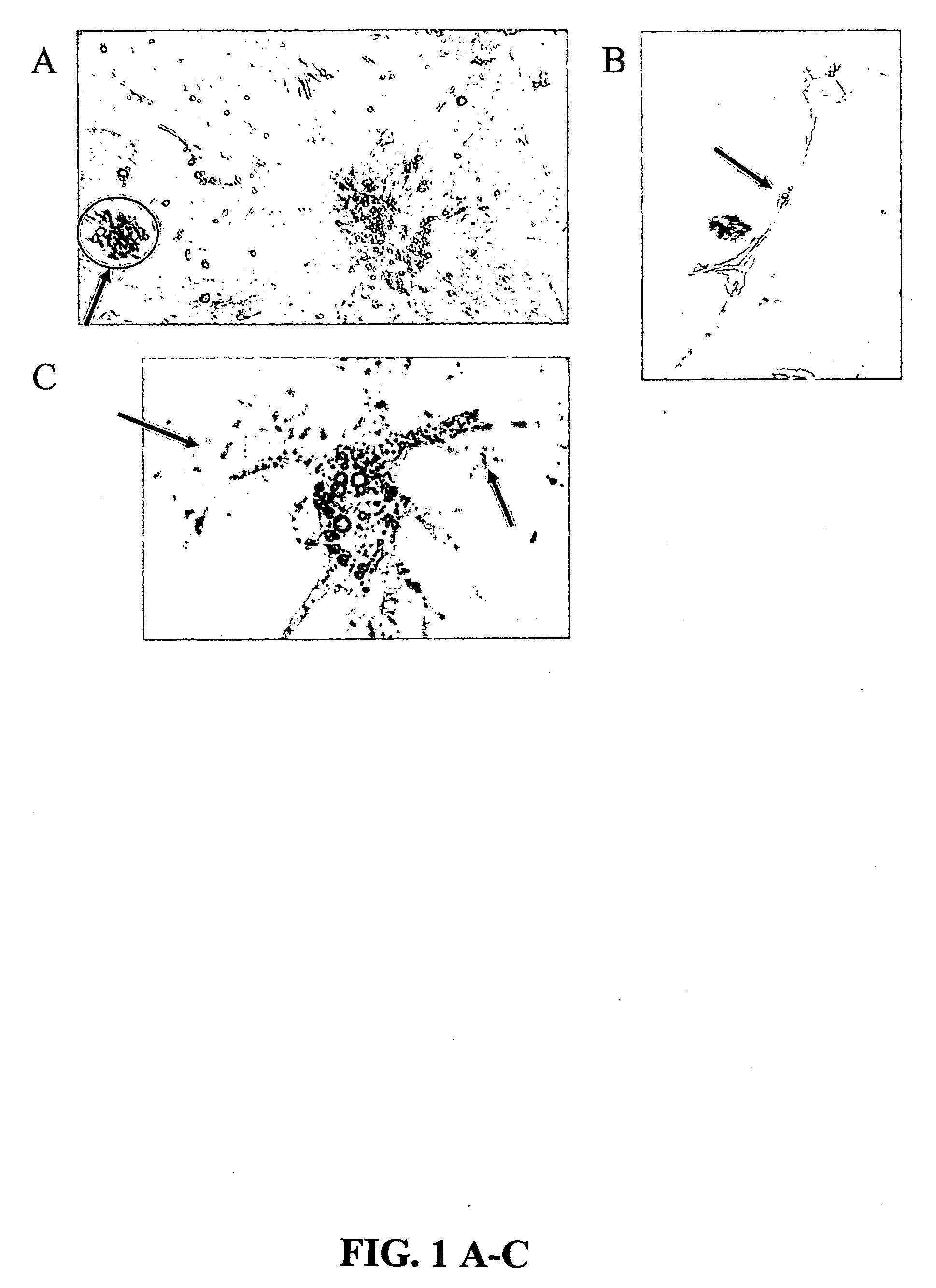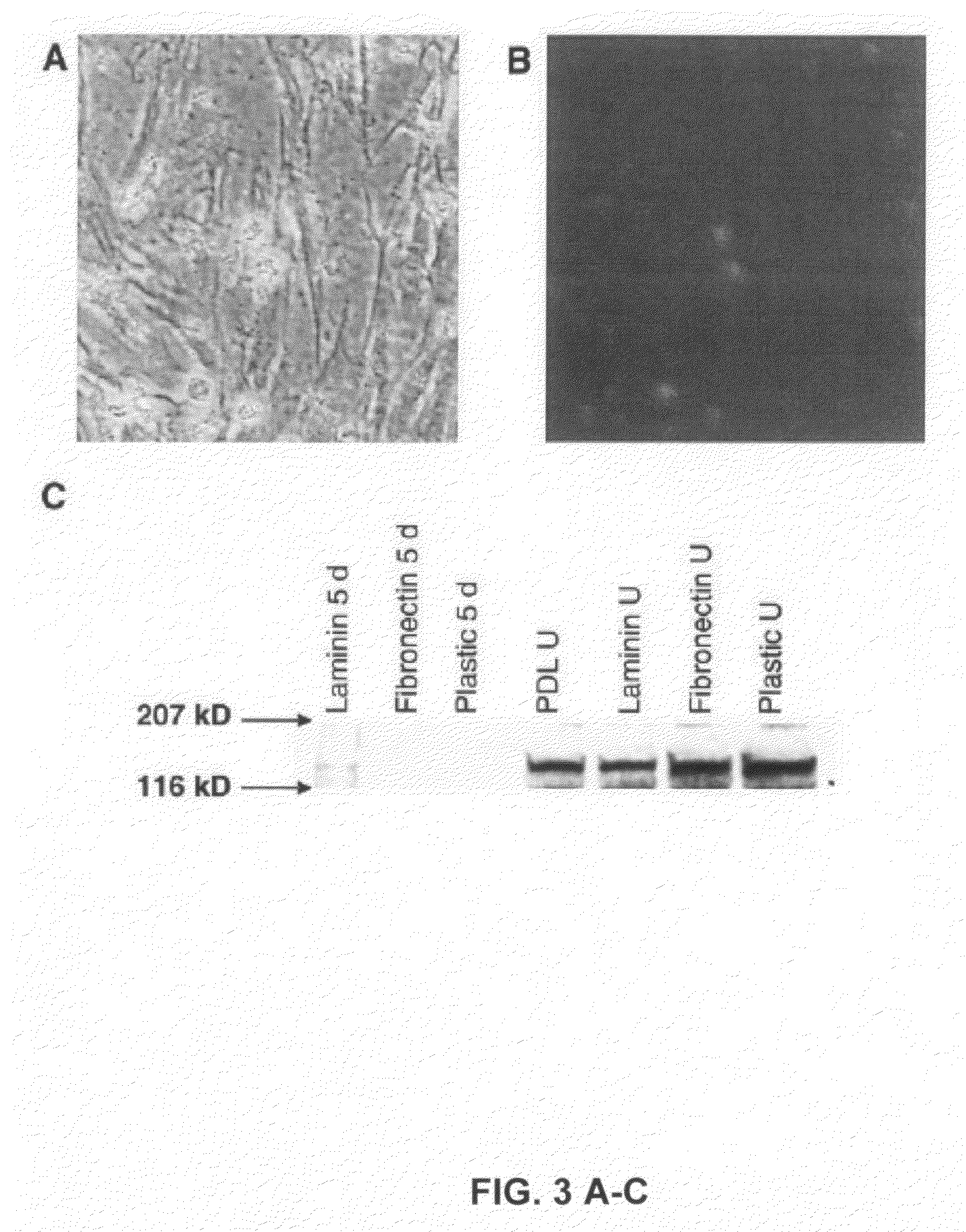Cultures, products and methods using umbilical cord matrix cells
a technology of umbilical cord and matrix cells, which is applied in the field of stem cell isolation and use, can solve the problems of ethical controversy over stem cell extraction from an embryo source, the inability to achieve therapeutically useful or pluripotent stem cells adults, and the inability to achieve pluripotent stem cells, etc., to achieve the effect of improving the results of implantation, reducing the symptoms of the disease, and measuring the activity of a cytotoxic compound
- Summary
- Abstract
- Description
- Claims
- Application Information
AI Technical Summary
Benefits of technology
Problems solved by technology
Method used
Image
Examples
example 1
UCMS Cells as Neural Cell Precursors
[0172]This experiment tested the hypothesis that Wharton's Jelly hold useful stem cells in an undifferentiated state. The Wharton's Jelly cells were identified as an easily attainable source of potentially multi-potent stem cells that can be maintained in culture.
Materials and Methods
[0173]Umbilical cords were collected and the serosa opened. Two types of sample were prepared. One was adherent to the serosa, the other adherent to the vessels. Each sample was exposed to mercaptoethanol, PBS, 10 mM MEDTA, 1 mM PMSI, 0.5% 2-mercaptoethanol and digested overnight. The sample was then dialyzed against water for 72 hours. The retentate had 40-80 μg / ml protein. Harvest procedure was adapted from Guerardel et al. (Biochem J 352: 449-463. 2000).
Induction of Neural Cells from UCMS Cells
[0174]We utilized a procedure based on the method described by Woodbury et al. [2000] to induce UCMS cells to become neural cells. The UCMS cells were pre-induced by overnigh...
example 2
UCMS Cells Propagate Vigorously
[0186]We have successfully propagated bovine, porcine, human, rat, and canine UCMS cells. UCMS cells have been maintained beyond 100 cell doublings and show no signs of decreased vigor.
[0187]The cells are derived from Wharton's Jelly matrix rather than cord blood because umbilical vessels are stripped from the cord before explant preparation and the cells are negative for markers of the hematopoietic lineage such as CD34 and CD45.
[0188]The UCMS cells have been subjected to harsh environmental conditions such as prolonged exposure to room temperature, prolonged periods without media replacement and culturing in serum-free media. In the latter case they all become spherical and thrive and divide as suspension cultures.
example 3
Characteristics of Undifferentiated Wharton's Jelly Cells
Materials and Methods
[0189]The TRAPeze® XL Telomerase Detection Kit (Intergen) was used according to manufacturer's instructions to measure the telomerase enzyme activity of porcine and human Wharton's Jelly cells. The TRAPeze® XL Telomerase Detection Kit uses a modified TRAP (Telomerase Repeat Amplification Protocol) assay to detect telomerase activity through the amplification of telomeric repeats using fluorescence energy transfer primers (Amplifluor™) that produce measurable fluorescence only when incorporated into TRAP products.
[0190]Porcine and human Wharton's Jelly cells that were grown in culture for 45 passages, were washed twice with PBS, and then frozen at −80° C. for 30 minutes. The cells were resuspended in 100 μl of CHAPS XL Lysis Buffer (included in the telomerase detection kit) and with 20 U of ribonuclease inhibitor (Promega). This suspension was incubated on ice for 30 minutes. The extract was pelleted (12,00...
PUM
| Property | Measurement | Unit |
|---|---|---|
| mass | aaaaa | aaaaa |
| molecular mass | aaaaa | aaaaa |
| molecular mass | aaaaa | aaaaa |
Abstract
Description
Claims
Application Information
 Login to View More
Login to View More - R&D
- Intellectual Property
- Life Sciences
- Materials
- Tech Scout
- Unparalleled Data Quality
- Higher Quality Content
- 60% Fewer Hallucinations
Browse by: Latest US Patents, China's latest patents, Technical Efficacy Thesaurus, Application Domain, Technology Topic, Popular Technical Reports.
© 2025 PatSnap. All rights reserved.Legal|Privacy policy|Modern Slavery Act Transparency Statement|Sitemap|About US| Contact US: help@patsnap.com



